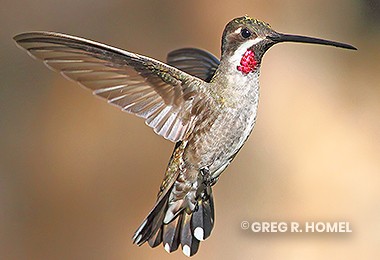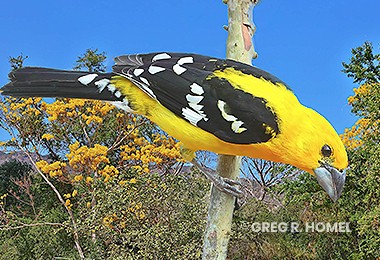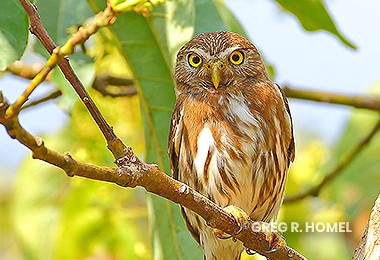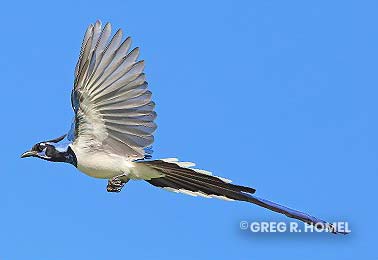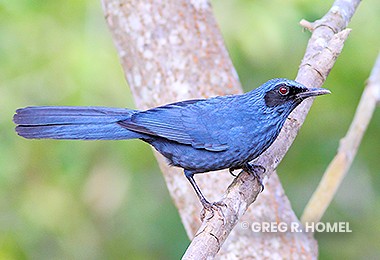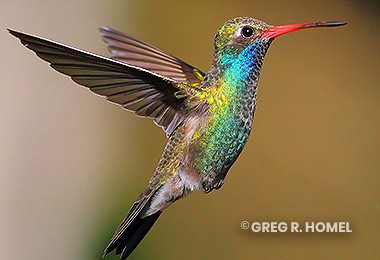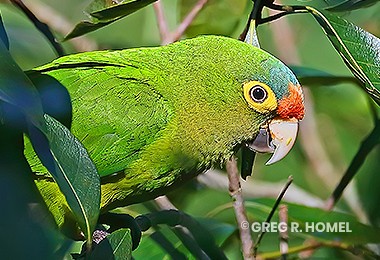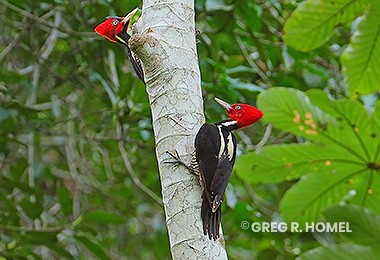Yelapa
Birds to Watch: 269
Location: Yelapa » Jalisco
GPS: 20° 29' 16.8756'' N / 105° 26' 44.1132'' W
Tropical Birding on the South Coast of Banderas Bay, Jalisco
Yelapa (population 1500+) is located on the lushly forested south coast of Banderas Bay. Its apropos name is derived from the indigenous Nahuatl language, meaning—“among waters!” This welcoming seaside town has recently attained fame in birding circles for being the only location on the coast of West Central Mexico where all three species of the nation’s hawk-eagles occur sympatrically, in addition to an astounding array of more common neotropical raptors, forest birds and flocks of Military Macaws! It is a fantastic birding destination for the whole family, and easily reachable from Puerto Vallarta via Highway #200 and an easy water taxi ride.
Tour Description
The indigenous community of Yelapa is a great place for both day and overnight trips from Puerto Vallarta. Birding in Mexico offers both.
This is a very special community where indigenous, Mexican and other cultures live in harmony surrounded by nature in Cabo Corrientes, without cars. The remarkable diversity of birds (369 recorded species) is reflected in its geographic position at the confluence of the eastern tropical Pacific and the most lushly forested north facing slopes of this cape — with its wide elevational gradients (Sea Level to 823 m / 2700’) and commensurately varied plant communities.
Tropical Birding Tour
Once there birding visitors can combine phenomenal birding with optional hiking to a beautiful waterfall, then lunch and a swim on the beach, all on the same day!
As if that were not enough of a draw, Yelapa is also unique in the area for having no cars, and its residents like it that way. You read that correctly…. No cars! As a result, its main access is by the sea via water taxi.
Join Birding in Mexico for either their one-day or overnight options at beautiful Yelapa. You’ll be glad you did. See you there!
*Please inquire for price and availability while providing your preference for joining our one day or overnight Yelapa Excursions.
B. Overview:
– State of the Republic: Jalisco
– Location: Cabo Corrientes, on the south side of Bahia de Banderas (Banderas Bay).
– Popularity of this tour: Moderately popular, not because the birding isn’t great… (it is), but because of its remoteness and the fact it has no direct road access.
Birding potential is very high here, partly because of its remoteness, and the fact that Yelapa is the best place to see large forest eagles in the entire Vallarta region!
*Sightings are not guaranteed, but we have resident birding contacts at Yelapa who keep us updated about recent sightings, making the expedition all the more exciting!
– Short description:
The indigenous community of Yelapa is a great place for both day and overnight trips from Puerto Vallarta. Birding in Mexico offers both.
This is a very special community where indigenous, Mexican and other cultures live in harmony surrounded by nature in Cabo Corrientes, without cars. The remarkable diversity of birds (369 recorded species) is reflected in its geographic position at the confluence of the eastern tropical Pacific and the most lushly forested north facing slopes of this cape — with its wide elevational gradients (Sea Level to 823 m / 2700’) and commensurately varied plant communities.
The predominant vegetation types — stratified according to elevation — include riparian woodland, Sinaloan thorn, palm, and tropical deciduous / evergreen forest, and even encinal (pine-oak-juniper woodland) at the highest elevations.
Combined with man-created grasslands, a lagoon, streams, and even a waterfall associated with the Rio El Tuito, provide a rich variety of habitats for all living creatures.
On our day trips — we explore Yelapa on foot, following the Rio El Tuito upriver, sometimes as far as the waterfall.
On our overnight trips — we include a visit to Yelapa Tapa in the highlands, where a waiting vehicle will transport us there, once we walk the needed 1 kilometer stretch on a good foot trail (moderately strenuous due to the uphill grade).
The predominant vegetation type is deciduous forest, although the conjunction of mountains grass-lands, lagoon, The Rio El Tuito drains from the vicinity of El Tuito, in the highlands, and the canyon of the Rio El Tuito cuts through protected Rancho Sanctuario, home to a successful Military Macaw nest box program. Both are visited on separate Birding in Mexico excursions.
*Please check the relevant page on this site if you are interested in those excursions
*Cars can get within about one click of Yelapa, via a long, if beautiful and contorted overland route (this is another offering by Birding in Mexico, from El Tuito), but the last part of the road was either never completed or washed away long ago and never rebuilt.
Yelapan Residents and most visitors like it that way—so although cars can almost reach the pueblo, they have to stay out of town.
This overland access is by terraceria (dirt-road) and is very difficult to negotiate outside of the dry season, running from November to May.
During this period Birding in Mexico utilizes this road on its overnight Yelapa excursions to provide ready access to a highland hang gliding stage called Yelapa Tapa, which does double duty as a mirador or viewpoint where birding guests can watch for neotropical raptors, macaws, guans and forest birds while taking in breathtaking, panoramic views of the sweeping coastline of Banderas Bay, all the way to Puerto Vallarta and beyond. Even the distant massif of the Sierra San Juan near San Blas can be seen on the clearest days!
– List of popular birds, with endemics highlighted in bold print: See full eBird lists by clicking the bird list tab
– Gallery: See Site Gallery by clicking this tour’s gallery tab
– Frequently Asked Questions: Click on this tour’s FAQ button for specifics
- Private Pickup
6:00a.m. sharp!
Birding in Mexico will cheerfully pick you up at either your hotel or a prearranged meeting point—usually the parking lot for Walmart / Sam’s Club off of Francisco Medina Ascencio — near the Liverpool Galleria — then whisk you away to begin your wonderful Yelapa adventure.*Timings are approximate. Please be punctual. Casual window birding en route. Depending on sea conditions, you may experience mild motion sickness during our 45-minuted water taxi transit to Yelapa. In rare instances storms will cancel the trip and we will reschedule or refund your payment.
*Birding in Mexico will provide complimentary motion sickness tablets if you request one, but be mindful they take about one hour to be fully effective. Once you’re sick, it’s too late! Nobody is immune and there is no shame. Please be honest with yourself and us if you think you are sensitive to motion sickness (or don’t know), and request a tablet upon pick-up. Thank you.
-
We start our day with welcome snacks and participant introductions
6:00 – 6:45 a.m.Followed by a lively description of your tour’s logistics, replete with a display map, so you can get your bearings.Following introductions we take Highway #200 south 23 kms / 45 minutes from Puerto Vallarta to the lively fishing village of Boca Tomatlan
After your private pickup utilizing a modern, high quality, air conditioned vehicle, we will follow coastal Highway #200 south from Vallarta, passing a beautiful array of still largely intact habitats… deciduous Sinaloan Thorn Forest, the coastline of the eastern tropical Pacific Ocean—even a small chain of islands known as Los Arcos National Park and Marine Reserve, where Brown Pelican, Neotropic Cormorant, Magnificent Frigatebird, Blue-footed and Brown boobies, and Gray-breasted Martins may easily be seen—to reach Boca Tomatlan, located at the mouth of the Rio Los Horcones, gateway to serene Yelapa, which is accessible by water taxi.
-
7:30-8:15 a.m.
(8-10 nautical miles / 45 minutes).Some commonly encountered birds seen during this relatively high speed water taxi transit include Brown Pelican, Magnificent Frigatebird, Blue-footed and Brown boobies, Laughing Gull, Royal Tern, etc. We may also see various Ardeids, coastal raptors such as Common Black-Hawk, and even Military Macaws along the coastline as we progress to Yelapa.There are small chances to encounter phalaropes, marine terns and even storm-petrels seasonally, farther offshore during the transit, and we will keep our eyes open for them.
*Restrooms available near the boat dock (not on the boats) and may be open. Usually we arrange a private watercraft for our transfer, depending on group size. These pangas are open air, and may or may not have a retractible sunshade. In the event a private craft isn’t available we will work within the timings of the water taxi concession at Boca Tomatlan, which usually runs on the half hour. Thank you for your patience and good cheer.
-
Arrival at Today’s Exciting Birding in Mexico Hotspot — Yelapa
8:15 a.m.We disembark on an elevated dock and walk along the rocky fringes of east Bahia Yelapa (Yelapa Bay) to enter a sweeping sandy beach leading to the estuary of the Rio El Tuito.
*If the dock is under construction or has been compromised, it may be necessary to disembark on a sandy beach, which, depending on the tide, may or may not require wading in shallow seawater. Able bodied staff will be there to assist.
The combination of Pacific shoreline, Sinaloan Thorn Forest on the hillsides, riparian woodland and sandy mudflats along the Rio El Tuito, combine to create a varied and rich birding bonanza for visiting birders.
The hillsides and ridges, cloaked in Sinaloan Thorn, palm and deciduous tropical forest in at Yelapa has been the site of frequent Black-and-White Hawk-Eagle sightings for years, and the estuary often produces Common Black Hawks, long-legged wading birds, and various shorebirds, cormorants, gulls and terns.
For specifics please see the corresponding bird lists by habitat, here
-
Breakfast Snacks & Birding on the Beach
8:15 – 8:45a.m.Complimentary breakfast snacks will be provided while birding to boost our energy levels this morning—“continental breakfast” if you would like. Usually, these consist of yogurt, fruit, juices, granola bars and other nutritious options. Cold, bottled fresh water and a selection of soft drinks — including diet options — are also readily available. We apologize if your preferred flavor is not available.
*There are public restroom facilities at Yelapa, though they may not be open, in which case we will request the use of the beach restaurants’ or other facilities.
While on the trail you may have to answer the call of nature outdoors, so please consider moderating your intake of diuretics like coffee and tea once we leave the beach.
-
Birding the Rio El Tuito
8:45 – 12.00 p.m.The Rio El Tuito winds its way from the highlands in the vicinity of El Tuito, to the coast at Yelapa.
A trail and several bridge spans provide access to a wide variety of riparian, garden, agricultural and forest birding opportunities in the vicinity of the river, replete lovely forests cloaking the adjacent hillsides all the way to a lovely waterfall.
As a special treat, Elegant Trogons are frequently seen along this trail in the morning hours, while Military Macaws fly overhead, sometimes with Bat Falcons hot on their trails.
For full birding specifics, see relevant bird lists here
*Our goal will not be to reach the waterfall, though we might. Rather, it is to glass the rich variety of interesting birds inhabiting the Yelapa area.
-
Comfort Stop, Lunch on the Beach and Bonus Birding Opportunities
12:00 p.m. – 2:00 p.m.Each day trip to Yelapa includes a sumptuous siesta-style lunch on the beach, after you’ve worked up a hearty appetite birding to your heart’s content during the morning.
Intermittent comfort stops are available only in the community of Yelapa and our beachside restaurant. In the wild backcountry there is only the “green latrine!”
*We appreciate your flexibility and good cheer in this respect.
Following lunch and swimming, time permitting, we will do some more brief birding, either in the Yelapa area or at Boca Tomatlan and the Canyon of the Rio Los Horcones.
-
Overnight Option with Yelapa Tapa and exploration of the highlands to 823 m / 2700’,
On the second day we will depart our hotel, taking a boxed breakfast with us, to reach Yelapa Tapa, with a possible expedition stop at the coastal hamlet of Pizota, accessible by crossing the highest forested ridges separating Yelapa Tapa and Pizota.
Military Macaw, Lilac-crowned Parrot, forest raptors, Crested Guan, White-collared Swift, Gray-crowned Woodpecker, Colima Pygmy-Owl, Tropical Parula, Red-crowned Ant-Tanager and Flame-colored Tanager are all likely to be sighted.
For a complete list of the possibilities, please see the relevant listings here
*All Birding in Mexico overnight trips are of course all-inclusive—including, transportation, guidance, room and board at a lovely hotel at Yelapa! Please inquire for pricing and availability.
-
Repatriation to your Hotel, Pickup Point or Home
5:00 p.m.Whether you’re opting for our day trip or overnight option to Yelapa, upon completion of all Birding in Mexico adventures, each participant will be cordially returned to their original pickup point, with pleasure, and it is our sincere hope that you’ll return to that point very pleased and richer for today’s Birding in Mexico experience.
Bird Watch List
** The number of birds per trip may change
To better prepare for the adventure that awaits you, please study the following lists:
Some of Yelapa’s star birds, stratified according to habitats, include, in season:
1. Bahia Yelapa and beaches: Black-necked Stilt, Sanderling, Greater Yellowlegs; Laughing and Heermann’s gulls; Black, Common (both migration), Royal and Elegant terns; Brown Pelican, Magnificent Frigatebird, Blue-footed and Brown boobies, etc.
2. Rio El Tuito and its estero at Playa Yelapa: A dozen species of herons and egrets, including Green Heron and Yellow-crowned Night-Heron; White and White-faced ibis; Osprey and Common Black Hawk; Green kingfisher; Mangrove Swallow; Northern and Louisiana waterthrushes, etc.
C. Sinaloan Thorn Forest, Palm Forest and Tropical forest: Thicket Tinamou; West Mexican Chachalaca and Crested Guan; Red-billed Pigeon; Groove-billed Ani, Lesser Ground-Cuckoo and Squirrel Cuckoo; Buff-collared Nightjar; Mexican Hermit, Plain-capped Starthroat, Golden-crowned Emerald, Mexican Woodnymph (rare), Broad-billed, Cinnamon and Violet-crowned hummingbirds; Hook-billed Kite, Black-and-White and Black hawk-eagles, Great Black Hawk, Zone-tailed, Gray, and Short-tailed hawks; Mottled Owl, Ferruginous and Colima pygmy-owls; Citreoline & Elegant trogons; Russet-crowned Motmot; Golden-cheeked, Pale-billed and Lineated woodpeckers; Collared Forest-Falcon, Bat Falcon; Lilac-crowned Parrot, Mexican Parrotlet (winter), Orange-fronted Parakeet and Military Macaw; Ivory-billed Woodcreeper; Masked Tityra, Gray-collared and Rose-throated Becards, Northern Beardless Tyrannulet, Greenish Elaenia, Pacific-slope, Vermilion, Dusky-capped, Nutting’s, Brown-crested, Social, Boat-billed, Sulphur-bellied flycatchers, Bright-rumped Attila, Great Kiskadee, Tropical and Thick-billed kingbirds; Golden, Black-capped, Bell’s, Warbling (the last three winter) and Yellow-green (summer) vireos; Black-throated Magpie-Jay, Green and San Blas jays; Happy and Sinaloa wrens; Blue Mockingbird; Orange-billed Nightingale-Thrush, Rufous-backed Robin; Scrub (Goldman’s) Euphonia; Rusty-crowned Ground-Sparrow, Stripe-headed Sparrow; Yellow-winged Cacique, Black-vented, Hooded and Streak-backed orioles; Golden-crowned, MacGillivray’s, Black-throated Gray (the last two winter), Fan-tailed and Rufous-capped warblers; Red-crowned Ant-Tanager, Yellow Grosbeak, Red-breasted Chat, Blue, Varied and Painted (winter) buntings; Blue-black Grassquit; Cinnamon-rumped Seedeater, and Grayish Saltator, etc.
3. Humid palm and tropical forest at Yelapa Tapa and bordering Camino Pizota: Ruddy Quail-Dove; Eared Poorwill and Mexican Whip-Poor-Will; Middle-American (Vermiculated) Screech-Owl; Chestnut-collared, Collared and Greater Swallow-tailed (rare) swifts; Calliope (winter) and Berylline hummingbirds; Arizona and Gray-crowned woodpeckers; Greater Pewee; Brown-backed Solitaire; Gray Silky-flycatcher; Elegant Euphonia; Black-headed Siskin; Tropical Parula, Grace’s Warbler and Slate-throated redstart; Hepatic, Flame-colored and Red-headed tanagers, etc.
All or most of following eBird Hotspots may be visited on this incredibly exciting Birding in Mexico destination, which includes an overnight option.
Please inquire for pricing then give us your preference, and we’ll gladly make it happen for you!
*See full eBird list of each site we will be visiting by clicking each specific bird list link, below:
1. Playa Yelapa (269 species): https://ebird.org/printableList?regionCode=L372467&yr=all&m=
2. Sendero Cascada Yelapa (130 species): https://ebird.org/printableList?regionCode=L8186519&yr=all&m=
3. Camino a Yelapa—Mirador (89 species): https://ebird.org/printableList?regionCode=L4695741&yr=all&m=
4. Selva El Tuito—Yelapa Tapa (100 species): https://ebird.org/printableList?regionCode=L3482040&yr=all&m=
5. Selva El Tuito—Camino Pizota (69 species): https://ebird.org/printableList?regionCode=L3667796&yr=all&m=
Recommended footwear for today’s excursion?
All-terrain shoes with ankle support are recommended; tennis shoes are also acceptable if you do not have high-top all terrain footwear.
What kind of Clothes should I Wear?
Lightweight clothing displaying neutral or earth tone colors (no bright colors or whites please, as they may alert often shy birds—such as the skulky Rosy Thrush-Tanager—to our presence from afar, preventing our close approach). We also recommended you don a hat or cap with a visor or brim (again, no bright colors or whites), to avoid glare and sunburn in the tropical climate we will be operating within.
Weather here at 600 m / 2000’ is usually very pleasant with mild temperatures. However, this is unpredictable. At any time of year Rancho Primavera’s weather can turn surprisingly cold, foggy or rainy, and quickly, so please carry a light duty windbreaker and a fleece to provide comfort during a sudden downpour, or warmth during the sometimes chilly early morning hours, respectively.
Sun Protection?
YES. We recommended using sun screen with a minimum sun protection factor of 16 (preferably 30 SPF or higher) on your face and other exposed skin to avoiding sunburns, especially in coastal, marine or high altitude environments.
Insect Repellent?
YES. During the dry season (November-May) biting insects are usually not very bothersome in Cabo Corrientes region generally, and Rancho Primavera specifically, but there are exceptions—especially where chiggers are concerned (as livestock is present on the Rancho), and you may not even realize you’ve been bitten until 12-24 hours after exposure; thereafter it’s too late and the itching can be formidable.
To be sure to avoid being bitten by chiggers, mosquitos or black flies, we recommended that you carry repellent with DEET as its active ingredient wherever you go, applying it liberally on an impromptu basis for mosquitos and black flies, while spraying your pant cuffs and socks for chiggers before every outing, regardless of the season.
You’ll be glad you did, especially during the wet season (June-October)!
We recommend a repellent that is sprayable via a non-aerosol propellent, also, since the pump style repellents may leak inside your daypack, potentially ruining your food, camera gear, or other often expensive equipment. Roll-on style repellents do not efficiently cover your skin’s surface, nor your pant cuffs or socks, so you are discouraged from using them in favor of a propelled spray.
Bring your Camera Gear
If you are an avid bird and / or wildlife photographer, Birding in Mexico offers select Bird Photography Expeditions with Greg R. Homel throughout Mexico, and the world, for that matter.
*Please inquire if you are interested in learning more about our bird and wildlife photography-oriented expeditions.
Our day trips—unless specified as bird photography-centric—are focused on birding specifically, and photography as an exciting sidebar. All tour participants are, of course, welcome to bring their cameras to practice this enjoyable pastime on all of our excursions.
Recommended equipment should include digital cameras with telephoto lenses equal to the equivalent of at least 400 mm for your bird photography efforts to be worthwhile in the first place.
Please don’t forget to bring extra batteries and memory cards specific to your camera brand.
Lens tissue should also be considered requisite to keep your lenses clean or to wipe incidental water or sea spray off of their (and your binoculars’) objective elements, as environmental conditions are unpredictable in the often wild regions we will be visiting.
What is this Expedition’s Level of Physical Difficulty?
Visitors to Yelapa will generally encounter easily negotiable trails and foot paths (some, steep with ruts, rocky stretches, wet or muddy conditions, depending on recent weather) in the lowlands, grading to more moderately challenging walks in the highlands near Yelapa Tapa.
You may also be required to board floating watercraft on the beach with no dock (we have able bodied staff to assist you), and may have to wade in shallow water between the shoreline and your boat, or cross the Rio Tuito on occasion, though this scenario is unusual.
Nonetheless, you should be prepared for this contingency with good cheer and a spirit of adventure.
We will provide free of charge, motion sickness options for the water taxi for sensitive individuals.
Walking conditions here range from EASY to MODERATE throughout the excursion.
There is a 823 m / 2700’ potential altitudinal gain on this excursion—depending on whether you day trip or overnight option—and you should be prepared for this, though our vehicle will be doing most of the “climbing” and overland travel for you.
Yelapa and surrounding birding areas are not wheelchair accessible.
If possible, we tend to adjust our walking pace to match the physical capabilities of each group.
In the event that two leaders will accompany your group (which is not guaranteed), it is possible that we will split the group to accommodated clients of varying athletic capabilities.
If you have specific concerns, please don’t hesitate to contact us in advance of your trip and we will do our best to provide you with accurate information pertinent to your specific needs, while advising you whether or not you would gain commensurately from the excursion you are contemplating.
What is Included on my Tour?
- All Birding in Mexico excursions include one or more specialized, Government-certified (applicable to Alejandro Martinez, a Mexican Citizen, or other Mexican guides), bilingual guide(s)
- Your guide(s) will carry their own private binoculars at all times during the tour, and where productive, a high quality spotting scope, as well
- Complimentary Birding in Mexico checklists specific to the region will be handed out at your pickup point and an excellent regional field guide authored by Greg R. Homel will be offered for sale
- Breakfast-snacks are included
- Throughout this tour, all meals, lodging, ground and water-borne transportation, entrance fees, complimentary snacks, fruit, purified water, and soft drinks are provided with pleasure
- Private ground transportation with pickup and drop-off between Puerto Vallarta and Boca Tomatlan is also included
- As is water taxi transportation to and from Yelapa and Boca Tomatlan
- For your safety and wellbeing a First aid kit is carried on all Birding in Mexico excursions
- If you are not a Mexican Citizen, please carry a valid copy of or your actual Passport (or Passport Card) on all Birding in Mexico excursions, since occasional government or military “Puestos” (road checks) may be encountered and require this.
- Mexican Citizens should have valid government-issued identification with them, as well
- Also it is wise to bring sufficient cash and your ATM card (please know your PIN), to cover unexpected expenses in the event of an emergency

